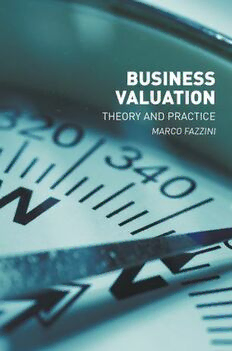Table Of ContentBUSINESS
VALUATION
THEORY AND PRACTICE
MARCO FAZZINI
Business Valuation
Marco Fazzini
Business Valuation
Theory and Practice
Marco Fazzini
European University of Rome
Rome, Italy
ISBN 978-3-319-89493-5 ISBN 978-3-319-89494-2 (eBook)
https://doi.org/10.1007/978-3-319-89494-2
Library of Congress Control Number: 2018938559
© The Editor(s) (if applicable) and The Author(s) 2018
This work is subject to copyright. All rights are solely and exclusively licensed by the Publisher, whether the
whole or part of the material is concerned, specifically the rights of translation, reprinting, reuse of illustrations,
recitation, broadcasting, reproduction on microfilms or in any other physical way, and transmission or
information storage and retrieval, electronic adaptation, computer software, or by similar or dissimilar
methodology now known or hereafter developed.
The use of general descriptive names, registered names, trademarks, service marks, etc. in this publication does
not imply, even in the absence of a specific statement, that such names are exempt from the relevant protective
laws and regulations and therefore free for general use.
The publisher, the authors, and the editors are safe to assume that the advice and information in this book are
believed to be true and accurate at the date of publication. Neither the publisher nor the authors or the editors
give a warranty, express or implied, with respect to the material contained herein or for any errors or omissions
that may have been made. The publisher remains neutral with regard to jurisdictional claims in published maps
and institutional affiliations.
Cover image © blackred/Getty Images
Cover design by Ran Shauli
Printed on acid-free paper
This Palgrave Macmillan imprint is published by the registered company Springer International
Publishing AG part of Springer Nature.
The registered company address is: Gewerbestrasse 11, 6330 Cham, Switzerland
To Cesare and Giacomo,
may they appreciate the value of what really matters in life
Preface
If you are leafing through this book you might wonder whether a new text-
book on business valuation is really necessary, as so many books have been
published on this subject in recent years. In my opinion there is still some-
thing to say; let me try to explain why.
First, many textbooks address business valuation as if the valuation method
were all that mattered.
In fact, most business valuation textbooks are specifically focused on calcu-
lation methods. Unquestionably, these play a very important role, as they are
the formal part of the entire process. The risk, however, is to place too much
emphasis on the quantitative dimension, without adequately considering the
context in which the valuation is made.
The method chosen is the result of a broader analysis through which the
characteristics of the firm are investigated. It is the method that must adapt to
reality not the other way around.
The purpose of this textbook is to offer a guideline for the application of an
integrated approach, thereby avoiding “copy and paste” valuations, based on
prepackaged parameters and the uncritical use of models. Specifically, an
Integrated Valuation Approach (IVA) should be adopted that encompasses,
within any specific method, a wide range of elements reflecting the character-
istics and specificities of the firm to be valued.
Secondly, many textbooks do not adequately consider the role of valuation
standards. In both the literature and professional practice, business valuation
is now circumscribed to some specific models, although many variations can
be found in their practical application. Valuation standards allow for an align-
ment of both the methods and their application, providing a common basis
for valuers. This book is based on the International Valuation Standards
vii
viii Preface
(IVS) issued by the International Valuation Standards Council. These stan-
dards significantly help the valuation work, both generally (scope of the work,
investigation and compliance, reporting, basis of value, valuation approaches
and methods) and specifically (business interests, intangibles, plant and equip-
ment, real property, development properties, financial instruments), and pro-
vide useful indications.
To write this book I had to take time away from my family; thus, I am
grateful to my wife Laura and my children for their patience and to whom I
dedicate this book.
Rome, Italy Marco Fazzini, PhD
Contents
1 V alue, Valuation, and Valuer 1
2 Integrated Valuation Approach (IVA) 23
3 Financial Statement Analysis 39
4 I ncome-Based Method 77
5 M arket-Based Method 123
6 T he Cost Approach 175
7 I ntangible Assets Valuation 183
8 P remiums and Discounts in Business Valuation 209
Index 219
ix
List of Figures
Fig. 1.1 Range of plausible values 5
Fig. 1.2 General requirements of a valuation report 14
Fig. 2.1 Investments and financial sources 34
Fig. 3.1 Functional reformulation of the balance sheet 43
Fig. 3.2 Relationship between assets and liabilities 43
Fig. 3.3 Reclassification example 44
Fig. 3.4 Net assets 45
Fig. 3.5 Working capital 45
Fig. 3.6 Business assets 45
Fig. 3.7 Non-current net debt 46
Fig. 3.8 Current net debt 46
Fig. 3.9 Net debt 46
Fig. 3.10 Financial statement at a glance 46
Fig. 3.11 The income statement 47
Fig. 3.12 Reclassified income statement 48
Fig. 3.13 Gross margin distribution 48
Fig. 3.14 Cash flow statement 49
Fig. 3.15 Example of financial statement 55
Fig. 3.16 Business assets 56
Fig. 3.17 Turnover of individual assets 58
Fig. 3.18 Mismatch between profit and cash flow 58
Fig. 3.19 Balance between investments and financial sources 66
Fig. 3.20 A part of current assets is covered by long-term sources 67
Fig. 3.21 A part of non-current assets is covered by current debt 67
Fig. 4.1 Asset-side and equity-side valuation 81
Fig. 4.2 The logic of discounting 83
Fig. 4.3 Comparison between the returns of different government bonds 87
xi
xii List of Figures
Fig. 4.4 CAPM at a glance 102
Fig. 4.5 Cash flows and EBITs trend 115
Fig. 5.1 Asset-side and equity-side approaches 129
Fig. 5.2 EV/EBITDA % change over one year 132
Fig. 5.3 EV/FCF and EV/Sales regression 141
Fig. 8.1 Basics of value. (Source: NACVA, Valuation Discount and
Premiums, 2012) 210
Fig. 8.2 Control premium and discount for lack of control 212

